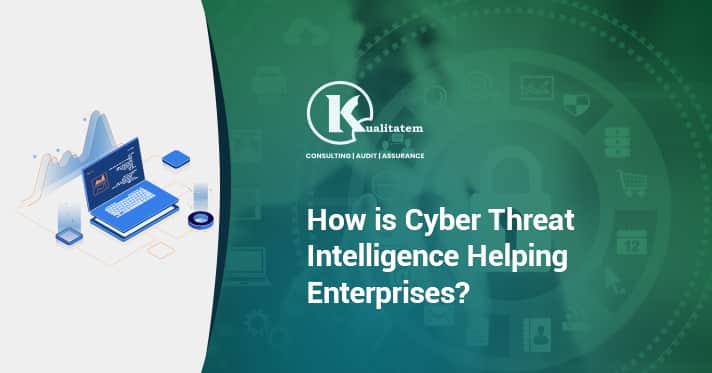How is Cyber Threat Intelligence Helping Enterprises?

- June 17, 2020
- saniaamir
Owing to the proliferation of technology and digitization, internet connectivity lies at the core of every business and industry. It is inarguable that the prevalence of innovative phenomena like artificial intelligence and the Internet of Things has revolutionized the industry and brought forth the utmost convenience for the customers. However, this is a double-edged sword as they introduce new threats and risks to the company. Organizations today – ranging from large to small and medium enterprises – face cyber-security challenges with regards to weak security infrastructure against malicious hackers. Almost every day, there is a headline about cyber-attacks and security breaches in the news. Even with the progression and advancement of technology for the security of the company, threat actors and hackers have sophisticated tools at their disposal to carry out malicious attacks. A recent study carried out by Ponemon Institute states that companies suffer a loss of about $8 million on average for every data or security breach, which roughly translates to the cost of $242 per record on average. In addition to this, ransomware attacks have been gaining traction in the industry over the past few years, in which the attackers lock the enterprise system and a hefty amount of ransom is demanded in exchange for unlocking it. As the threats and risks across the industry increase every day, the cybersecurity testing companies are stuck between a rock and a hard place as they have to increase their speed to keep up with the growing challenges without making a compromise on the quality.
In 2018, a major data breach attack was carried out against the million billion corporate giant, Amazon, in which the personal details of the millions of users including names, passwords, emails, and other details were illegally accessed for fraudulent purposes. Thus, when even the biggest companies in the world with a network spanning the globe need security measures surpassing the industry standards, it becomes clear that change is required when it comes to ensuring cyber security.
What is Threat Intelligence?
One of the main insights which have been derived from the previous attacks is that the main way to stay vigilant against the prevailing cyber-attacks and for building a robust cyber threat intelligence program is through threat intelligence. According to Gartner, “Threat intelligence is evidence-based knowledge, including context, mechanisms, indicators, implications, and action-oriented advice about an existing or emerging menace or hazard to assets. This intelligence can be used to inform decisions regarding the subject’s response to that menace or hazard.” The main purpose of cyber threat intelligence is to collect and analyze information about the current and potential risks and threats in the future. It is a security measure that facilitates the companies in determining their weak nodes and vulnerabilities and possible attacks which pose a risk to the security of their IT infrastructure. By exploring the security system of the organization and identifying vulnerabilities and attack vector points in the system, cyber threat intelligence allows the organization to build stronger and robust defense strategies and frameworks while keeping their weaknesses in the account. Considering that threat intelligence opens the avenues for the companies to gain a better vision of threats and risks in their infrastructure and an understanding of what is happening within the security network, the overall areas of potential attack for the enterprises are also reduced substantially.
Data regarding the existing and potential future attacks is gathered from multiple sources by the threat intelligence team and a comprehensive report outlining all scenarios is generated. The role of the cyber threat intelligence team here is that they evaluate the collected data to ensure its authenticity by removing all false positives from the data. The insights and results derived from the report can also be used by the IT and automatic security solutions teams to make precise decisions about the security. In this way, cyber threat intelligence arm the teams across the organization with corrected and updated knowledge about zero-day threats, latest exploits, and potential risks so that they can build robust security firewalls.
Why is Cyber Threat Intelligence Critical for Companies Today?
With the flood of information that the cybersecurity testing companies get every day which is full of extraneous data, false alarms, and irrelevant material across various, unconnected security systems, it is becoming increasingly hard to sieve through all data to retrieve relevant material. In addition to this, there is a stark lack of professional and skilled personnel who can manage the intelligence adequately. Consequently, many enterprises are scrambling to embed the intelligent data into their network, however, the teams are not trained so they might not know how to deal with all the data. This further adds to the pressure of analysts as they are not equipped with the sophisticated tools and measures to categorize the data adequately, and may not know which parts to prioritize and which to discard completely.
However, with a proper cybersecurity threat intelligence solution program at their disposal, the teams can easily cater to the challenges that are mentioned above. The most effective threat intelligence solutions use artificial intelligence and machine learning systems to automate the data collection and processing stage which not only reduces the probability of error but is also less time-consuming. Machine learning specifically helps the teams to integrate their existing solutions with new data and systems so that the unstructured data collected from various sources can be processed automatically. With this solution aligned with machine learning, the team is able to connect the dots through the provided context on the tactics, strategies, methodologies, and procedures of hackers, and on the indicators of compromise. Furthermore, the threat intelligence program provides actionable insights with context so that it is easily understood, in a timely manner, and creates a platform for shared knowledge which in turn allows effective collaboration and ascertains that everyone in the team is on the same page.











